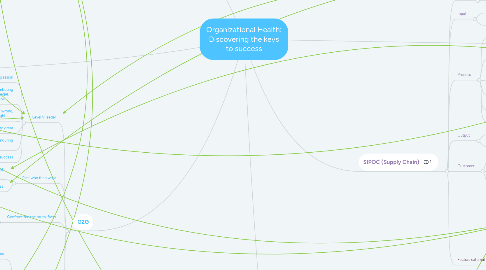
1. Iceberg Concept
1.1. Logic
1.1.1. Tip of the iceberg (10-15%)
1.2. Culture
1.2.1. values, visual, veiled
1.3. Power
1.3.1. Nodes of Power
1.3.1.1. preferred combo of referent and legitimate
1.3.2. Types
1.3.2.1. Referent
1.3.2.2. Informal
1.3.2.3. Force
1.3.2.4. Character (inter/intrapersonal)
1.3.2.5. Mirror
1.3.2.6. Formal
1.4. Politics
1.4.1. to advance self/organization
1.5. Group Dynamics
1.5.1. forming, storming, norming, performing
1.6. Ego
1.6.1. Big
1.6.1.1. Kanye West song (Big Ego)
1.6.2. Strong
1.6.2.1. Reflective, grounded, humble, passionate, selfless, knows limits
1.6.2.2. Level V leader
1.6.3. Strong/Big
1.6.3.1. Ideal leader
1.6.4. Big/Strong
2. Business context
2.1. Corporate (effective)
2.1.1. Mission/Vision/Value
2.1.2. C-Suite (CEO, CFO,CMO)
2.1.2.1. Level V leaders
2.1.3. 3 big financial statements
2.1.3.1. cash flow, profit/loss, balance sheets
2.2. Competitive (effective)
2.2.1. Marketing
2.2.1.1. create competitive advantages that are unique, valuable, and difficult for rivals to copy/substitute
2.3. Functional (efficiency)
2.3.1. Process
2.3.1.1. SPC
2.3.1.2. Non-value added-waste(TIMWOODx2)
2.3.1.2.1. transport
2.3.1.2.2. inventory
2.3.1.2.3. motion
2.3.1.2.4. waiting
2.3.1.2.5. over processing
2.3.1.2.6. over production
2.3.1.2.7. defects
2.3.1.2.8. waste of human potential***
2.3.1.2.9. unnecessary product/service
2.3.1.3. Non-value added-required
2.3.1.3.1. regulation
2.3.1.4. Value added work
2.4. Build strategy around (1) employees, (2) patients, (3) shareholders
2.4.1. Starbucks
2.5. OA
2.5.1. Functional areas
2.5.1.1. finance/accounting
2.5.1.2. operations
2.5.1.3. marketing
2.5.1.4. HR
2.5.1.5. IT
2.5.1.6. Supply chain
2.5.2. Primary activities of management
2.5.2.1. plan
2.5.2.2. organize
2.5.2.3. staff
2.5.2.4. direct
2.5.2.5. control
2.5.2.6. coordinate
2.5.2.7. report
2.5.2.8. budget
2.5.3. strategic management process
2.5.3.1. intended
2.5.3.1.1. unrealized
2.5.3.2. realized
2.5.3.2.1. emergent
3. G2G
3.1. Level V leader
3.1.1. Humility + passion
3.1.2. Highly capable individual, contributing team member, competent manager, effective leader, level V executive
3.1.3. looks in the mirror when things go wrong, out the window when things go right
3.1.4. transform companies from good to great
3.1.5. sets standard in building enduring company
3.1.6. sets up successors for even greater success
3.2. First who then what
3.2.1. get the right people on the bus in the right seats
3.2.2. retrain as opposed to finding outside hires
3.3. Confront the the brutal facts
3.3.1. create culture where truth is heard
3.3.1.1. lead with questions
3.3.1.2. engage in dialogue and debate
3.3.1.3. conduct autopsies without blame
3.3.1.4. build red flag mechanisms
3.4. Hedgehog concept
3.4.1. Fox
3.4.1.1. Fast, sleek, able to pounce
3.4.1.2. metaphorically scattered, diffuse
3.4.2. Hedgehog
3.4.2.1. simple, organized, methodological
3.4.2.2. single idea, principle, concept organizes world
3.4.2.3. what can you be the best at, profound insight
3.4.2.4. passion, world leader, economic engine
3.5. Culture of Discipline
3.5.1. disciplined people
3.5.2. disciplined thought
3.5.3. disciplined action
3.6. technology accelerators
4. House of Lean
4.1. Customer Focus
4.1.1. Highest quality, lowest cost, shortest lead time by decreasing muda
4.1.1.1. new vs old equation
4.1.1.1.1. old: cost+profit=price
4.1.1.1.2. new:price(fixed)-cost=profit
4.1.2. maximize customer value
4.1.2.1. value equations
4.1.3. perfect value with zero waste
4.1.3.1. TIMWOODx2
4.2. Just-in Time
4.2.1. Coveys 2x2
4.3. Jidoka
4.3.1. technology
4.4. Standardization
4.4.1. Deming 14 points of quality
4.4.1.1. constantly innovate/improve
4.4.1.2. adopt new philosophy
4.4.1.3. cease mass inspection
4.4.1.4. dont award on basis of price alone
4.4.1.5. use SPC
4.4.1.6. train OJT
4.4.1.7. improve management and supervision
4.4.1.8. drive out fear
4.4.1.9. break down barriers between debts and with suppliers
4.4.1.10. eliminate slogans
4.4.1.11. eliminate work standards
4.4.1.12. remove barriers to pride in workmanship
4.4.1.13. retrain
4.4.1.14. create management that embraces these principles
4.4.2. Deming 7 deadly diseases
4.4.2.1. lack of constancy of purpose
4.4.2.2. emphasis on short-term profits
4.4.2.3. annual reviews
4.4.2.4. management turnover
4.4.2.5. running company on visible figures alone
4.4.2.6. excessive medical costs
4.4.2.7. legal fees, warranty costs
4.4.3. what gets measured gets done, what gets done gets rewarded, what gets rewarded gets repeated
4.5. Stability
4.5.1. SPC
4.6. Centered around employee involvement
4.6.1. Get the right people on the bus-G2G
5. SIPOC (Supply Chain)
5.1. Supply
5.1.1. leading indicators
5.2. Input
5.2.1. raw material
5.2.2. leading indicators
5.3. Process
5.3.1. decrease rework=process perfection
5.3.2. Deming chain reaction
5.3.2.1. improve quality, decrease rework, improve productivity, more efficient, lower prices, increase market share, expand business, increase jobs, produce more product, lower prices...
5.3.2.1.1. reflective practice
5.3.3. SPC
5.3.4. bottlenecks/constraints
5.3.4.1. flow error
5.3.4.1.1. can cause buildup earlier in SIPOC chain, starvation/waiting later in chain
5.3.5. leading or lagging?
5.3.6. WIP, MRO
5.4. Output
5.4.1. finished product
5.4.2. lagging indicators
5.5. Customer
5.5.1. also think about consumer
5.5.2. feedback loops
5.5.3. lagging indicators
5.6. Factors external to an industry
5.6.1. Porters 5 Forces model of industry competition
5.6.1.1. Suppliers
5.6.1.1.1. bargaining power
5.6.1.2. Potential entrants
5.6.1.2.1. threat
5.6.1.3. Company
5.6.1.3.1. industry rivalry
5.6.1.4. Substitutes
5.6.1.4.1. threat
5.6.1.5. Buyers
5.6.1.5.1. bargaining power
5.6.2. STEEPL
5.6.2.1. Sociocultural
5.6.2.1.1. more women in workplace, increase in temporary workers, postponement of having children
5.6.2.2. Technological
5.6.2.2.1. genetic engineering, CAD/CAM, wireless communication
5.6.2.3. Economic
5.6.2.3.1. interest rates, unemployment, GDP, stock market
5.6.2.4. Environmental
5.6.2.4.1. currency exchange rates, trade agreements
5.6.2.5. Political/legal
5.6.2.5.1. increase in minimum wages, AHCA, taxation
6. Metrics
6.1. Statistical Process Controls (SPC)
6.1.1. Control charts
6.1.1.1. Common cause variation
6.1.1.1.1. stable process
6.1.1.1.2. track data, try to improve
6.1.1.1.3. within UCL & LCL
6.1.1.1.4. stratify, disaggregate, experiment
6.1.1.2. Special cause variation
6.1.1.2.1. unstable process
6.1.2. X-bar
6.1.3. Bell Curve
6.1.3.1. normal distribution
6.2. Change management strategy
6.2.1. Change curve
6.2.1.1. 1. Status quo
6.2.1.1.1. shock/denial
6.2.1.2. 2. Chaos
6.2.1.2.1. depression/anger/resistance
6.2.1.2.2. internally focused
6.2.1.3. 3. Exploration
6.2.1.3.1. hope/acceptance
6.2.1.3.2. externally focused
6.2.1.4. 4. Rebuilding
6.2.1.4.1. commitment
6.2.2. 8 steps of managing change
6.2.2.1. establish sense of urgency
6.2.2.2. form a powerful guiding coalition
6.2.2.3. create a vision
6.2.2.4. communicate vision
6.2.2.5. empower others to act on vision
6.2.2.6. create short-term wins
6.2.2.7. consolidate improvements and produce still more change
6.2.2.8. institutionalize new approaches

